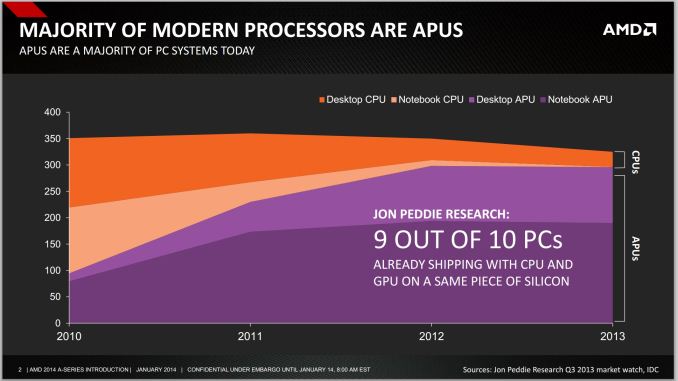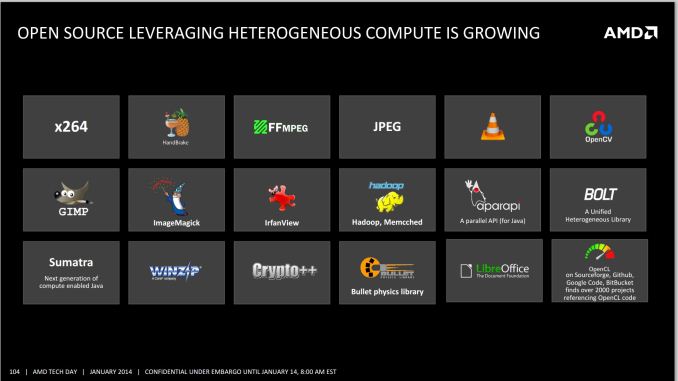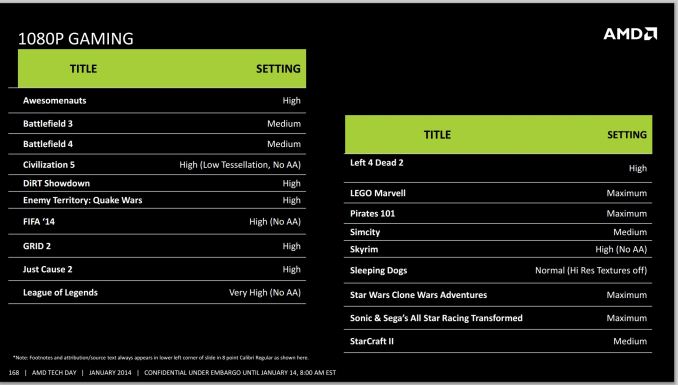AMD Kaveri Review: A8-7600 and A10-7850K Tested
by Ian Cutress & Rahul Garg on January 14, 2014 8:00 AM ESTKaveri: Aiming for 1080p30 and Compute
The numerical differences between Kaveri and Richland are easy enough to rattle off – later in the review we will be discussing these in depth – but at a high level AMD is aiming for a middle ground between the desktop model (CPU + discrete graphics) and Apple’s Mac Pro dream (offloading compute onto different discrete graphics cards) by doing the dream on a single processor. At AMD’s Kaveri tech day the following graph was thrown in front of journalists worldwide:
With Intel now on board, processor graphics is a big deal. You can argue whether or not AMD should continue to use the acronym APU instead of SoC, but the fact remains that it's tough to buy a CPU without an integrated GPU.
In the absence of vertical integration, software optimization always trails hardware availability. If you look at 2011 as the crossover year when APUs/SoCs took over the market, it's not much of a surprise that we haven't seen aggressive moves by software developers to truly leverage GPU compute. Part of the problem has been programming model, which AMD hopes to address with Kaveri and HSA. Kaveri enables a full heterogeneous unified memory architecture (hUMA), such that the integrated graphics topology can access the full breadth of memory that the CPU can, putting a 32GB enabled compute device into the hands of developers.
One of the complexities of compute is also time: getting the CPU and GPU to communicate to each other without HSA and hUMA requires an amount of overhead that is not trivial. For compute, this comes in the form of allowing the CPU and GPU to work on the same data set at the same time, effectively opening up all the compute to the same task without asynchronous calls to memory copies and expensive memory checks for coherency.
The issue AMD has with their HSA ecosystem is the need for developers to jump on board. The analogy oft cited is that on Day 1, iOS had very few apps, yet today has millions. Perhaps a small equivocation fallacy comes in here – Apple is able to manage their OS and system in its entirety, whereas AMD has to compete in the same space as non-HSA enabled products and lacks the control. Nevertheless, AMD is attempting to integrate programming tools for HSA (and OpenCL 2.0) as seamlessly as possible to all modern platforms via a HSA Instruction Layer (HSAIL). The goal is for programming languages like Java, C++ and C++ AMP, as well as common acceleration API libraries and toolkits to provide these features at little or no coding cost. This is something our resident compute guru Rahul will be looking at in further detail later on in the review.
On the gaming side, 30 FPS has been a goal for AMD’s integrated graphics solutions for a couple of generations now.
Arguably we could say that any game should be able to do 30 FPS if we turn down the settings far enough, but AMD has put at least one restriction on that: resolution. 1080p is a lofty goal to hold at 30 FPS with some of the more challenging titles of today. In our testing in this review, it was clear that users had a choice – start with a high resolution and turn the settings down, or keep the settings on medium-high and adjust the resolution. Games like BF4 and Crysis 3 are going to tax any graphics card, especially when additional DirectX 11 features come in to play (ambient occlusion, depth of field, global illumination, and bilateral filtering are some that AMD mention).













380 Comments
View All Comments
SofS - Wednesday, January 22, 2014 - link
Following your links and looking around I found:http://www.tomshardware.com/reviews/core-memory-sc...
It links to previous similar articles concerning the Phenon II and the i7 of the time (975). Seems that indeed the C2Q does not benefit much from memory improvements compared to the other two, but there is a difference. This and all of those three cases are relevant since all three models were very popular. Also, I remember choosing the on time smaller modules for my first kit whit this particular system since they were the only reasonable DDR3 modules at 1600 within reach, albeit I never managed to stabilize it at CL6. On the other hand the latter I upgraded with got CL6 from XMP since the beginning while being larger. Given that memory is very cheap compared to the whole system plus the cost of repurchasing non portable software then this (maybe also a new GPU) might just be the final push needed to wait for the next generation native DDR4 systems for many.
fokka - Tuesday, January 14, 2014 - link
i understand your sentiment, but then again, about every modern mainstream cpu should destroy a c2d and even quad in raw performance. and you even get relatively capable integrated graphics included in the package, so about everyone even moderately interested in computing performance and efficiency "should bite the bullet" if he's got a couple hundred bucks on the side.just4U - Wednesday, January 15, 2014 - link
and that's the problem.. their not. "It's good enough" Numbers are.. just that numbers. We hit a wall in 2008 (or there abouts..) and while performance kept increasing it's been in smaller increments. Over the span of several generations that really can add up but not the way it once did.It used to be you'd get on a old system and it would be like pulling teeth because the differences were very noticeable and in some cases they still are.. but for the most part? Not so much.. not for normal/casual usage. There is a ceiling .. Athlon X2s P4s? No.. you'll notice it.. Quad 8x Core2? hmmm.. How about a socket 1366 cpu or the 1156 stuff? Or the PIIs from AMD. Those people should upgrade? Certainly if their board dies and they can't replace.. but otherwise not so much.
just4U - Wednesday, January 15, 2014 - link
That should have read Quad 8x series Core2s.. anyway these days It seems like we do a lot more change out video, add in ssd, increase ram, rather then build systems from the ground up as systems can stick around longer and still be quite viable. Yes/no?tcube - Thursday, January 16, 2014 - link
Totaly agree. We're led to believe that we need to upgrade every 2 years or so... yet a great many are still using old cpu's even dual cores with new software and os without a care in the world. Because there is no noticeable improvement in cpu usage. Cpu power became irrelevant after C2Q nothing beyond that power is justifiable in normal home or office usage. Certainly certain professional users will want a cheap workstation and will buy into the highend pc market likewise extreme gamers or just for bragging rights. But thinking that for anything from browsing to medium photoshop usage or any moderate videoediting software use will REQUIRE anything past a quadcore like lowend i5's or this kaveri is plain false. You will however notice the lack of a powerful gpu when gaming or doing other gpu intensive tasks... so amd has a clear winner here.I do agree it's not suited for heavy x86 work... but honestly... most software stacks that previously relied heavily on cpu are moving to opencl to get a massive boost from the gpu... photoshop being just one of many... so yeah the powerful gpu on kaveri is a good incentive to buy, the x86 performance is better then richland which is sufficient for me(as i currently do use a richland cpu) so...
Syllabub - Friday, January 17, 2014 - link
I am not going to try and pick a winner but I follow your line of reasoning. I have a system with a e6750 C2D and Nvidia 9600 that still gets the job done just fine. It might be described as a single purpose type of system meaning I ask it to run one or possibly two programs at the same time. What I think is pretty wild is that when I put it together originally I probably sank something close to $250 into the CPU and GPU purchase while today I potentially get similar performance for under $130 or so. The hard part is buying today in a manner that preserves a level of performance equivalent to the old system; always feel the tug to bump up the performance ladder even if I don't really need it.Flunk - Thursday, January 16, 2014 - link
That doesn't really make sense unless you also include equivalently-priced current Intel processors. People may be moving on from Core 2s but they have the opportunity to buy anything on the market right now, not just AMD chips.PPB - Tuesday, January 14, 2014 - link
Adding a $350 CPU plus $50 GPU to a iGP gaming comparison = Anandtech keeping it classy.MrSpadge - Tuesday, January 14, 2014 - link
You do realize they're not recommending this in any way, just showing the full potential of a low-end discrete GPU which wouldn't be bottlenecked by any modern 3+ core CPU?Homeles - Tuesday, January 14, 2014 - link
PPB being an ignorant critic, as usual."For reference we also benchmarked the only mid-range GPU to hand - a HD 6750 while connected to the i7-4770K."